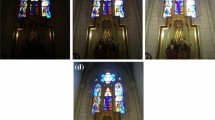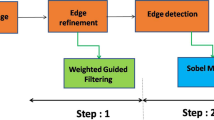Abstract
This paper introduces low-level operators in the context of detecting cylindrical axis in 3D images. Knowing the axis of a cylinder is particularly useful since its location, length and curvature derive from this knowledge. This paper introduces a new gradient-based optimal operator dedicated to accurate estimation of the direction toward the axis. The operator relies on Finite Impulse Response filters. The approach is presented first in a 2D context, thus providing optimal gradient masks for locating the center of circular objects. Then, a 3D extension is provided, allowing the exact estimation of the orientation toward the axis of cylindrical objects when this axis coincides with one of the mask reference axes. Applied to more general cylinders and to noisy data, the operator still provides accurate estimation and outperforms classical gradient operators.
Similar content being viewed by others
References
Coindreau O., Vignoles G.L., Goyhénèche J.-M. (2005). Multiscale X-ray CMT of C/C composites: a tool for properties assessment. Ceram. Trans. 175: 77–84
Bosmans H., Wilms G., Dymarkowski S., Marchal G. (2001). Basic principles of MRA”. Eur. J. Radiol. 38(1): 2–9
Coindreau O., Vignoles G.L. (2005). Assessment of structural and transport properties in fibrous C/C composite performs as digitized by X-ray CMT. Part I: Image acquisition and geometrical properties. J. Mat. Res. 20: 2328–2339
Plouraboué F., Cloetens P., Fonta C., Steyer A., Lauwers F., Marc-Vergnes J.-P. (2004). High resolution X-ray imaging of vascular networks. J. Microsc. 215(2): 139–148
Pal N.R., Pal S.K. (1993). A review of image segmentation techniques. Pattern Recognit. 6(9): 1277–1294
Lakare, S.:3D Segmentation Techniques for Medical Volumes, Center for Visual Computing, Department of Computer Science, State University of New York, http://www.cs.sunysb.edu/~mueller/teaching/cse616/sarangRPE.pdf (2000)
Chang Y.L., Li X. (1994). Adaptive image region growing. IEEE Trans. Image Process. 3(6): 868–872
Verdonck, B., Bloch, I., Maître, H.: Accurate segmentation of blood vessels from 3D medical images. In: ICIP’96—IEEE Int. Conf. on Image Processing, Lausanne, pp. 311–314 (1996)
Hernandez Hoyos, M.: Segmentation anisotrope 3D pour la quantification en imagerie vasculaire par résonance magnétique, Ph.D. Thesis (2002)
Langs G., Peloschek P., Bischof H. (2003). Determining Position and Fine Shape Detail in Radiological Anatomy. LNCS 2781: 532–539
Winkelbach S., Westphal R., Goesling T. (2003). Pose estimation of cylindrical fragments for semi-automatic bone fracture reduction. LNCS 2781: 566–573
Rabbani, T., van den Heuvel, F.: Efficient hough transform for automatic detection of cylinders in point clouds. In: Proc. the 11th Annual Conference of the Advanced School for Computing and Imaging (ASCI ’05). Het Heijderbos, Heijen, The Netherlands (2005)
McInerney T., Terzopoulos D. (1996). Deformable models in medical image analysis: a survey. Med. Image Anal. 1(2): 91–108
Xu, C., Phan, D.L., Prince, J.L.: Image segmentation using deformable models, Handbook of Medical Imaging, vol.2, Chap. 3 SPIE Press, California (2000)
Chan, T.F., Vese, L.A.: Active contour and segmentation models using geometric PDE’s for medical imaging. Geometric Methods in Bio-Medical Image Processing, Series: Mathematics and Visualization, pp. 63–75 Springer, Heidelberg (2002)
Cohen L.D., Cohen I. (1993). Finite element methods for active contour models and balloons for 2D and 3D images. IEEE Trans. Pattern Analysis Machine Intelligence 15(11): 1131–1147
Krissian K., Malandrain G., Ayache N. (2000). Model-based detection of tubular structures in 3D images. Comput. Vis. Image Underst. 80: 130–171
Russ J.C. (1995). Image Processing Handbook, 2nd edn. CRC press, Boca Raton
Canny J.F. (1986). A computational approach of edge detection. IEEE Trans. Pattern Anal. Mach. Intell. 8(6): 679–698
Le Pouliquen F., Da Costa J.-P., Germain C., Baylou P. (2005). A new adaptive framework for unbiased orientation estimation in textured images. Pattern Recognit. 38: 2032–2046
Author information
Authors and Affiliations
Corresponding author
Rights and permissions
About this article
Cite this article
Mulat, C., Donias, M., Baylou, P. et al. Optimal orientation estimators for detection of cylindrical objects. SIViP 2, 51–58 (2008). https://doi.org/10.1007/s11760-007-0035-2
Received:
Revised:
Accepted:
Published:
Issue Date:
DOI: https://doi.org/10.1007/s11760-007-0035-2




